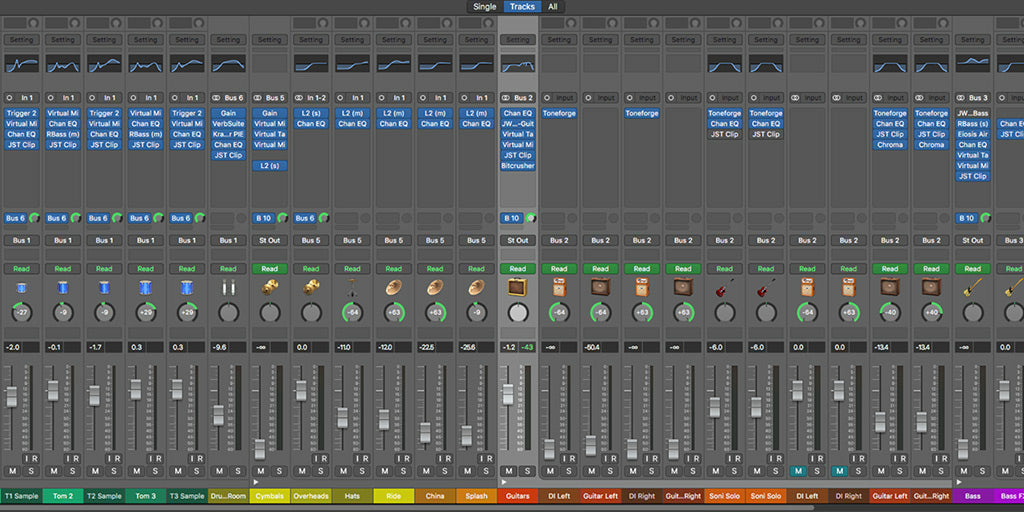How To Create Quick, Dynamic Mixes
In general, mixing is a process that is largely reactionary. You don’t go into a mix preemptively knowing what you’re going to have to do to get everything cleaned up and sounding like it should. Sure – you might have some general wisdom or starting points, but every single mix is different and requires your specific attention.
You can always have your own system in place though – where to start, what to look for first, pitfalls you can avoid early on… These are all common sense wisdom to the pros mixing day in and day out.
Here are some of the places you should start if you’re looking to build up a quick mix without getting too far off the path wasting time while mixing your way through the unknown. Use these key areas to keep yourself organized and moving forward toward the end product.

Set Your Levels
One of the most basic aspects of being a mixer starts with your levels – turning things up or down in your mix so they’re easier to hear. We can go ahead and include panning into this category as well. Before you think about reaching for a single compressor, EQ, or limiter, make sure your levels are set.
The easiest way to make sure you’re getting the right levels is to think in 1 dB increments. Add a dB to a sound that’s too soft and reevaluate. Is it still too quiet? Add another. Too loud? Bring it back down and start looking for what’s masking it that you might be able to turn down.
Working in this manner not only gets you a great static mix, but it gives you some valuable insight that you can leverage a bit later when you start working with some plugins. You’ll build up a familiarity with the problems a session has and hopefully start formulating a solution as you go so the roadmap is ready by the time you get there.

EQ
Once you’ve set your levels, reach for the EQ next. We’re not after our transients yet, so there’s no need for a compressor or limiter here. Instead, we’re after problem frequencies and simple solutions.
Use your EQ to create separation between tracks and give them their own space within the frequency spectrum. If there’s too much of any given frequency, use subtractive EQ to turn it down. If there’s not enough of another frequency, boost with the EQ to give it a little extra.
Don’t get caught up on dialing the EQs in perfectly. In a quick mix, creating separation is your goal. You can always come back to refine those EQ moves later on if needed.

Compression
Now we’re getting into the true dynamics of your mix! Compression is one of the most common tools in a producer’s toolbox. It gives you a way to control and warp your dynamics to fit the sonic palette you’re after. Squashing something with a compressor (or limiter) can really give it some added aggression, while lighter compression at lower levels can help round things out.
How you use your compressors is up to where you see them fitting in the best, but I always like to set up my bus compression early on. By using something like Bus Glue Billy Decker on my subgroups and aux tracks, I can START from a point where there’s already some compression gluing everything together. This helps make future decisions about the mix easier to envision in context of the final sound.

Reverb Techniques
It’s really hard to create a full, dynamic mix without some reflections and space setting the vibe of a song. Enter: your reverbs. Creating some basic reverb aux tracks that you can send instruments to can be a low-effort way of creating some space around your tracks.
A great method for setting up reverb in a quick mix is to take a three setting approach. By creating a short, medium, and long reverb, you’ll have three very different options you can experiment with as you work through your mix. If you don’t like how one sounds on your vocal, simply swap the send to a longer or shorter reverb and keep moving!
It’s pretty common that these reverbs eventually get broken out into instrument-specific resources. After all, part of the great flexibility of working in the box is that you can work with everything independently if you need to. Of course, there are just as many engineers that embrace the bleed and cohesion created by using a shared verb, so it’s not exactly uncommon for mixers to leave things “as-is” beyond the final mix.

Once again, it all comes back to you and what you think is appropriate or fitting for that particular session.
Advanced Dynamics
If you’re able to perfect these three things, you should be able to get to a great starting point in just minutes of opening a session. After you’ve got a quick mix down – the real work begins. The work of adding parallel techniques and automation is no easy task, but it’s one I think you’re up to the task for.
Come check out some of our advanced technique tutorials and courses in the JST VIP section when you think you’re ready.









